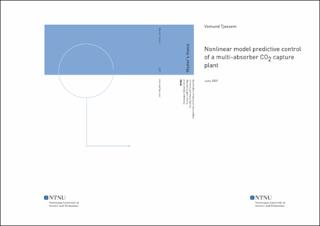| dc.contributor.advisor | Hillestad, Magne | |
| dc.contributor.advisor | Gjertsen, Fredrik | |
| dc.contributor.advisor | Hauger, Svein Olav | |
| dc.contributor.advisor | Singstad, Peter | |
| dc.contributor.author | Tjessem, Vemund | |
| dc.date.accessioned | 2021-10-21T18:24:08Z | |
| dc.date.available | 2021-10-21T18:24:08Z | |
| dc.date.issued | 2021 | |
| dc.identifier | no.ntnu:inspera:82941058:13546434 | |
| dc.identifier.uri | https://hdl.handle.net/11250/2824818 | |
| dc.description.abstract | I et etterforbrenning karbonfangstanlegg blir det brukt en aminløsning for å absorbere CO2. Aminløsningen blir regenerert i desorberkolonnen gjennom varme tilført i omkokeren. En stor driftskostnad ved et karbonfangstanlegg er energitilførselen i omkokeren. Det ble i denne masteroppgaven utviklet en kontrollkonfigurasjon for et karbonfangstanlegg med multiple absorbere, basert på ulineær modellbasert prediktiv regulering (NMPC). Målfunksjonen ble formulert på et vis som styrer anlegget mot minimalt energiforbruk samtidig som settpunkt på fansgtgrad opprettholdes.
En modell av et karbonfangstanlegg mottatt fra Cybernetica AS ble utvidet til å inkludere multiple absorberkolonner. Modellen ble delt i to deler, en med absorberkolonnene og en med desorberkolonnen og de andre enhetsoperasjonene. Flere enkle absorbermodeller ble utviklet og kombinert med desorberhalvdelen av modellen i to-NMPC kontrollkonfigurasjoner. Konfigurasjonene ble testet og utviklet til en endelig kontrollstruktur ble ferdigstilt.
De utviklede to-NMPC konfigurasjonene ble testet og sammenlignet med en referansekonfigurasjon. Referansekonfigurasjonen bestod av én NMPC som bruker den originale modellen. Den originale modellen ble benyttet som anleggerstatningsmodell i Cybernetica RealSim i alle simuleringer. I motsetning til to-NMPC konfigurasjonene hadde ikke referansekonfigurasjonen modellavvik fra anlegget. To-NMPC konfigurasjonene hadde varierende ytelse, men den endelige konfigurasjonen hadde sammenlignbar ytelse med referansekonfigurasjonen med en 73.6 % reduksjon i gjennomsnittlig beregningstid per sampel. Det ble også utviklet en annen konfigurasjon med en individuell NMPC for hver absorberkolonne som reduserte den gjennomsnittlige beregningstiden med 83.1 %.
Resultatene viste at de utviklede kontrollkonfigurasjonene kunne levere akseptabel ytelse med redusert beregningstid. Reduksjonen i beregningstid blir enda viktigere jo flere absorberkolonner som blir lagt til i anlegget. | |
| dc.description.abstract | In post-combustion CO2 capture, CO2 is absorbed in an amine solvent. The solvent is regenerated in the desorber column by heat supplied in the reboiler. A large cost when operating a post-combustion CO2 capture plant is the reboiler duty. In this master's thesis, a control configuration based on nonlinear model predictive control (NMPC) was developed for a multi-absorber CO2 capture plant, the objective function was formulated in a way that should control the plant towards minimum reboiler duty.
A CO2 capture plant model received from Cybernetica AS was expanded to include multiple absorber columns. The model was split into two parts, one with the absorber columns and one with the desorber column and the other process units. Several simple absorber models were developed and paired with the desorber half of the model in two-NMPC control configurations. The configurations were tested and developed until a final control structure was produced.
The developed two-NMPC configurations were tested and compared with a benchmark control configuration. The benchmark control configuration consisted of one NMPC using the original model. The original model was used as the plant replacement model in Cybernetica RealSim in all simulations, so the benchmark controller had no model mismatch with the plant, unlike the two-NMPC configurations. The two-NMPC configurations exhibited varying performance, but the final configuration offered comparable performance to the benchmark controller with a 73.6 % reduction in average computational time per sample. There was also developed another configuration with individual NMPCs for each absorber column, which reduced the average computational time by 83.1 %.
The results showed that the developed control configurations could deliver acceptable performance while reducing the computational time. The time reduction becomes increasingly significant the more absorber columns are added to the plant. | |
| dc.language | eng | |
| dc.publisher | NTNU | |
| dc.title | Nonlinear model predictive control of a multi-absorber CO2 capture plant | |
| dc.type | Master thesis | |
